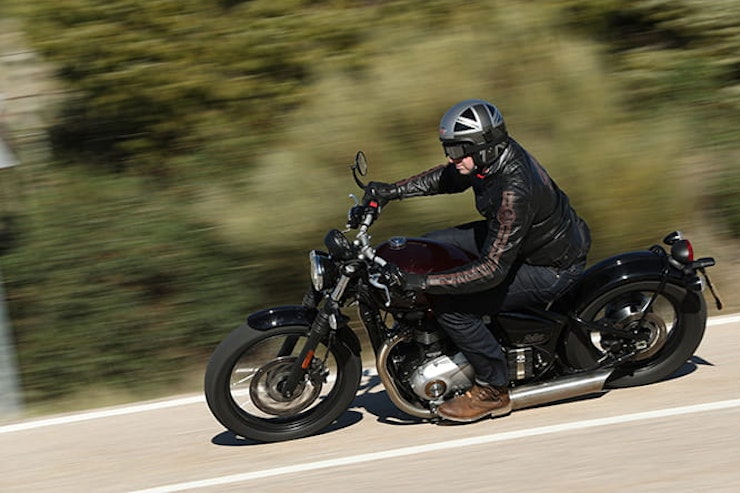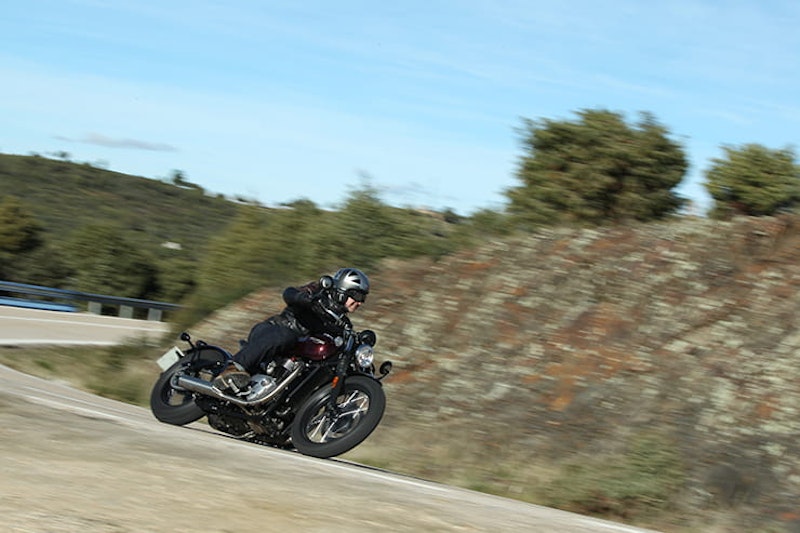Triumph Bonneville Bobber (2017) - First ride review
By Michael Mann
BikeSocial Managing Editor
12.12.2016
For a bike that was only announced two months ago there’s been plenty of hype around Triumph’s latest addition to the Bonneville range – the Bobber, the majority of which has been positive.
That already speaks volumes about the Bobber’s potential selling power. As does the very fact that the Hinckley-based manufacturer spent a fortune on the glamorous (by bike launch standards) launch event in a grungy/trendy warehouse in South East London. It’s a tell-tale sign of how many eggs a company are putting into their motorcycle-shaped basket. Triumph even announced this was their “most anticipated launch” and I’m going to put it out there straight away; they could be onto a winner. Oh yes.
Modern classics is the fastest growing category for Triumph and even with the success of the Street Twin and Thruxton range over the last 12 months, a spokesman for the British brand told us that forward orders for the Bobber are double compared to the Thruxton’s this time last year…and that’s even before the price, weight, power or torque figures were confirmed. They have just been announced today, immediately after the 130-mile press launch ride here in Madrid.
So to fill in any blanks, the headline figures are; prices start OTR from £10,500, it’ll be in UK dealers by the middle of February, it weighs 228kg (dry), makes 76bhp @ 6100rpm with the red line around 7000rpm and delivers 78.2lbs-ft @ 4000rpm.
Bobber’s were THE style of bike to be seen on in the 1940s, during the post war boom and Triumph’s take on the modern classic custom resurgence in the shape of a production model comes designed to match the original style. Think of the brief to be along the lines of imposing with a single seat unit, flat and low bars, short mudguards and stripped back with minimal bodywork. The engine has to be torquey with a decent strong, possible unique, exhaust note.
The new Triumph ticks all the boxes and then some.
Engine: grunty yet smooth
The 1200cc, 8 valve, SOHC, parallel twin cylinder, liquid cooled engine is straight from the Bonneville T120, just slightly retuned for more low down power and torque.
New intake system and new exhaust system plus a twin air box set-up offer more character than the grandfatherly T120.
The maximum power is down from 79bhp @ 6550rpm from the T120 to 76bhp @ 6100rpm on the Bobber, and it’s the latter of the two that makes more power lower down the rev range, 10% more at 4500rpm for example. A sign of urgency to get to flat out as quickly as possible, just like the original Bobbers used to.
The tall gears help push the bike on quickly with 2nd and 3rd optimal for most of the riding during the press launch – fast, flowing and smooth mountain roads mixed with the slower yet open-hairpins. The Bobber could take it all in its stride with minimal gear changing. That said, the clutch is extremely light, ideal for a novice rider even making it an easy bike to ride.
6th is almost unnecessary and is there as an overdrive for motorway cruising to keep the revs low and the mpg as high as possible. At 70mph in top, the engine’s ticking over at 3000rpm and is remarkably quiet. The red line is at 7000rpm and even though the sound improves with the more revs you feed in, even when pushing on the Bobber doesn’t need to be worked hard.
Styling wise, the apparently straight-through twin exhausts are cleverly disguised because, in a signature Bonneville style, below the rear brake lever they divert into a catalytic converter and back out into the brushed stainless steel, peashooter style, silencers. The rather unique twin airbox set up with two filters sit below the seat unit and we are promised a “specific Bobber soundtrack”.
The thump of the parallel twin is hearty from low rpm as you wind it on.
BikeSocial Video Review: Triumph's all-new Bobber
Watch our video review following the first ride of the Triumph Bobber!
Performance & Handling: it shouldn’t but it does
The Triumph Bobber is deceptive in terms of performance. Probably one of the biggest surprises is how agile the bike is in spite of its bulk. A tubular steel twin cradle frame isn’t light and contributes to the Bobber’s 228kg (dry) weight – that’s the same as a Honda Africa Twin – yet its performance and road handling belies its style and weight. Steering is light and the change direction is faster than you’d expect because if low centre of gravity.
Pushing on around the mountain roads to the north of Madrid and the Avon Cobra tyres also are worthy of a metaphorical pat on the back. They held the road really well at both high and low speed, outperforming their appearance and they formed a neat partnership with the traction control which interfered with a gentle tap as opposed to all-out slap, cutting power.
The 19” front and 16” rear tyres were chosen deliberately because of their performance. Test rider Felipe Lopez told me that the suited the bike the best after testing a range of alternatives.
A ride-by-wire throttle is coupled with two riding modes; Road and Rain, separated only by the delivery of the power instead of restricting the bhp. The modes can be adjusted on the fly by a quick flick of the relevant button on the right side of the bars and a dip of the clutch. Traction control can be turned off but only when stationary, while ABS comes as standard which is quite the norm with modern day regulations.
At the press launch we covered 130 miles and while the 9.1 litre tank is small to fit with the Bobber’s styling, it empties pretty quickly. Triumph claim 69mpg and a range of 138miles. That might be the case if you’re riding like mpg was the priority. Realistically, and the press launch pace wasn’t too far from real world riding, I achieved 51.5mpg and found the fuel warning light shining at me after just 67 miles. Talking to other journalists afterwards and some didn’t even achieve 50mpg.
When heading out for your first ride be careful of the front, 310mm single disc brake especially if you’ve been used to riding a modern machine with twin discs and/or a four-pot caliper. I’m not usually a rear brake user but it not only helped slow the big Bobber in a straight line but also helped with stability in the faster turns.
Ground clearance isn’t a bobbers’ forte and should you ride enthusiastically then you’ll be scraping your way through the hero blobs in no time.
Styling: as original as it could be
Fitting with the heritage Bobber-style, the low, single seat, wide flat bars and hard tail look all complement the completely new chassis, frame and suspension.
The front end was intentionally designed to match the Bonneville range. "A very British Bobber", said Mile Perkins, Triumph’s Head of Brand Management.
Wire-spoked wheels are suspended by KYB forks with 90mm travel at the front and a mono shock with 77mm travel at the rear located underneath the floating seat. For a bike that should be at home at low speeds, cruising around the city streets taking its rider to the next café or tattooist, the suspension works as well as can be expected. It’s not plush nor is it adjustable but it does what it’s supposed to without jarring or me booking a visit to the chiropractor. It’s like saying a MotoGP bike would be rubbish green-laning.
Neat touches around the bike add to the the high build quality including the brushed engine covers, branded fuel locking cap, highly effective bar end mirrors polished detailing and tank badges.
Riding position: adjustable seat and clocks
The suspension is assisted by the riding position. Unlike some of its rivals such as the Harley-Davidson Forty-Eight or Yamaha’s XV950, the Bobber uses its rider’s feet position, positioned slightly further back, to act as added suspension.
The seat is adjustable and provides an alternate riding position depending if its in the slightly more forward and higher setting or further back and lower. In the latter of the two the seat height is just 690mm and because the Bobber has a tiny waist where it meets the fuel tank, the standover is ideal for the shorter rider. Remove one bolt, loosen four more and slide the seat into your position, it takes just a couple of minutes providing the tools are at hand.
For a bobber-style I couldn’t complain about the comfort. It’s never going to be a touring bike so I don’t expect to be covering epic mileage in one sitting so it’s a blessing that the fuel tank size is so puny. The later in the day it got, the more I attempted to avoid potholes.
The exhaust had protectors covering the very area my size 10s Furygan boots were rubbing against – a neat and well thought-out touch. With balls of the feet on the pegs, my heels were lying right over the exhaust so with a little wear and tear they might not look as beautiful as when straight out of the factory.
The single clock is also adjustable. No bolts need removing or loosening for this though – just a quick-release lever and you can adjust to suit viewing angle or riding position. I didn’t bother. It’s quirky but ultimately a solution to a problem that never existed in my mind.
Accessories: over 150 available plus two ‘packages’
The name of the game with both the original bobbers and the modern day customising scene is to personalise your bike.
Cruise control and heated grips aside, the magnificent selection of seats, handlebars, levers, covers, bags, lights, mirrors and much more will leave you feeling like your bike is a one-off but if you’re lacking creativity then Triumph have come up with two ‘inspiration kits’ (pictured below):
Old School: including ‘ape hanger’ bars, a brown leather seat and swing arm bag - £1610 inc. VAT but exc. Fitting
Quarter Mile: including low clip-on bars, blacked out silencers and a headlight surround - £1500 inc. VAT but exc. fitting
I asked Stuart Woods, Triumph’s Chief Engineer for his top three accessories and he’d go with clip on bars plus a short front and rear mudguard.
If I was buying a Bobber then my three would be the Ironstone colour choice with blacked-out Vance & Hines silencers, some kind of comfort seat and the side-mounted number plate holder.
Colours, Price and Availability
Available from approximately Valentine’s Day in UK dealers from £10,500 and in four colours; Jet Black, Morello Red (+£125), Ironstone (+£125) and Competition Green/Frozen Silver (+£300).
Rivals
Victory Octane - £9799
Indian Scout - £10499
Harley-Davidson Forty-Eight - £9675
Yamaha XV950 (Bolt) - £7199
Moto Guzzi V9 Bobber/Roamer: £7999/£7899
Verdict
The Bobber really is a surprisingly cracking combination of looks and handling. The chassis is really capable at speed and the torquey 1200cc engine paints over the 76bhp figure. It just proves that power isn’t everything.
The sound it makes is worthy of a Christmas number one and I enjoyed every minute of riding it. I’m already looking forward to the next time I swing a leg over one.
On the flipside, the wiring loom around the handlebars looks a bit naff, the small fuel tank might annoy some and those exhaust protectors aren’t going to cope with wear and tear in the long term. The rear mudguard and number plate holder look cumbersome but unfortunately the regulations state that it’s necessary, which is why the accessory side number plate holder isn’t EU homologated.
Photo credits: Alessio Barbanti, Matteo Cavadini, Paul Barshon and Freddie Kirns

